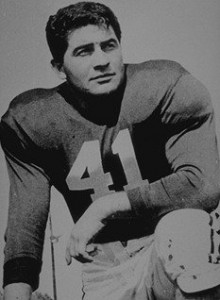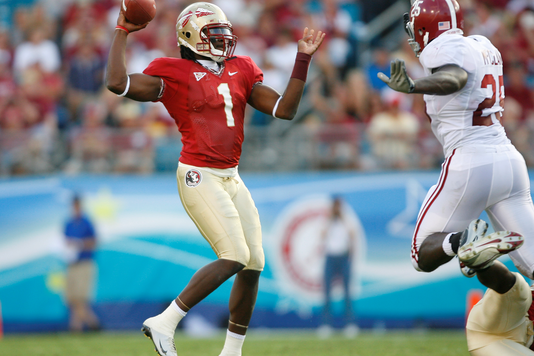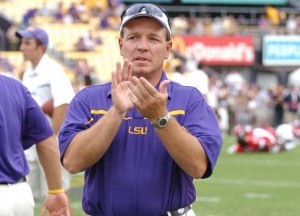In 2017, a football game will occur in Atlanta between the Florida State Seminoles and the Alabama Crimson Tide. On the surface, it seems just like a good move for schedule strength and financial reasons. A high profile match-up between two of the elite college football programs in the nation in a major city spells Money with a capital M.
If it’s a good game, well, that’s just a side effect right? Neither gets hurt much in their quests for their respective conference championships, and it serves as a good test for a potential playoff match-up.
But the game means something a bit more than that. Money and exposure and schedule boosting is fun, but it doesn’t really get to the heart of why this game is a culmination of each team’s personal history with the other one.
Indeed, even though they operate in two completely different conferences with separate histories, both FSU and Alabama have connections that run deep. Older fans have a better idea of just where the two begin to influence each other, but younger ones might not know the full backstory to how things came to be.
So where does it begin? 1959, actually. A man by the name of Vaughn Mancha took the Athletic Director position at FSU after being an assistant at the college from 1952 to 1956. It’s a bit of a distant story, but one that should set the tone for the later events that would transpire.
 Mancha was born in Sugar Hill, Georgia and went to high school in Birmingham, Alabama. Even though a childhood accident had blinded him in one eye, Mancha didn’t stop pursuing his dream of both serving his country and playing football. After a stint in the Merchant Marines, Vaughn decided that it was time to see just how good he could be on the football field.
Mancha was born in Sugar Hill, Georgia and went to high school in Birmingham, Alabama. Even though a childhood accident had blinded him in one eye, Mancha didn’t stop pursuing his dream of both serving his country and playing football. After a stint in the Merchant Marines, Vaughn decided that it was time to see just how good he could be on the football field.
From 1944 to 1947, Mancha lettered as a center and linebacker for Alabama under head coach Frank Thomas. He was a Consensus All-American in 1945 and team captain in 1947 while his team compiled a 30-9-2 record over his years. Mancha played in two Sugar Bowls and one Rose Bowl before playing in the NFL for a few years. Injuries forced him to retire, and that’s where his legacy at Florida State begins.
After coaching Livingston State University — now West Alabama University — for three years which included a victory over the Seminoles in 1949, Mancha was hired as an assistant to head coach Don Veller at FSU. Even after a head coaching change in 1953, Mancha stayed with the program through 1956. He went to Columbia University for two years to continue his education before returning to the school to head its athletic department.
Mancha oversaw FSU athletics from 1960 to 1972 and it was under him that the school first made serious strides in its sports achievements. The trophy case might not be full of awards from his era, but it’s an unfair metric to judge him by.
The program was pretty much in its infancy when Mancha came along. His hiring of Bill Peterson led FSU football to many historic firsts: This includes a top-10 ranking, a victory over Florida, recruitment of African Americans, and a bowl streak. Mancha also used his connections with SEC teams to schedule games with Alabama, Kentucky, and Georgia.
These contests, which included victories over Kentucky and Georgia, brought FSU notoriety and respectability on a national stage. Under his leadership, FSU would also begin the long and twisted path of trying to be admitted to the SEC — something that had been floated around but never really pushed for. The former Alabama star did all he could before his retirement from the position in 1972, after which he still taught at Florida State before retiring for good.
While it isn’t the most direct observation, Mancha’s legacy at Florida State would set the scene for a Seminole surge in the 1980’s. The program would be incredibly different without his time at Alabama and without his influence in scheduling certain opponents. In fact, it could be argued that he was the first of three influential men that came to Florida State due to Alabama. The other two? Bobby Bowden and Jimbo Fisher.

JACKSONVILLE, FL – JANUARY 01: Head coach Bobby Bowden of the Florida State Seminoles is carried off the field by his players after defeating the West Virginia Mountaineers during the Konica Minolta Gator Bowl on January 1, 2010 at Jacksonville Municipal Stadium in Jacksonville, Florida. Florida State defeated West Virginia 33-21 in Bobby Bowden’s last game as a head coach for the Seminoles. (Photo by Doug Benc/Getty Images)
On to Bowden, but most already know his backstory. Born and raised in Birmingham with a love for the game that propelled him to greater heights as both a coach and a person, Bowden played quarterback at the University of Alabama before transferring to Howard College (now Samford University) and afterwards getting into coaching. Originally a wide receiver coach at FSU from 1963 to 1965, Bowden eventually returned to be the head coach after a stint as head man of the West Virginia Mountaineers. He began in 1976 and the rest is history.
However, part of that history is the interesting segment that gets elaborated in this long form by Joe Posnanski. For quite some time, Bowden had thought that FSU was a sort of stepping stone job. His dream was to go back to his home state and coach the famed University of Alabama.
In 1986, it looked like this dream might become a reality after Bowden had received a call from eventual Governor Guy Hunt saying that they wanted Bowden to be the next head coach. Bowden said yes under one condition — that he would not have to interview for the job. He had already proven his worth as a coach at both West Virginia and then-lowly Florida State. But then:
“…Bowden showed up to meet school President Joab Thomas, and he saw 17 other people in the room, he began to get a sinking feeling. He sunk even lower when one of the people in the room, Walter Lewis – the first African-American to start at quarterback for the Crimson Tide – asked Bowden if he would feel comfortable starting a black quarterback.
“I already did at West Virginia 15 years ago,” Bowden said, wearily. They did not know him at all. They were talking to him like he was an unknown assistant at some unknown school. Even though Thomas and Alabama had broken his only condition – they were clearly interviewing him for the job – Bowden still would not give up on coaching at Alabama. He would remember playing the perfect interviewee, telling them just what he thought they wanted to hear — that he would coach just like Bear Bryant did with grueling training camps and toughness and motivation. He basically spoke against every principle that had marked his coaching – THAT is how badly he wanted to coach at Alabama. And when the meeting broke up, Bowden realized something.
“They didn’t offer me the dadgum job,” he would say.”
Bowden would head back to Tallahassee and see a legendary dynasty be built. Starting the next season in 1987, Florida State would not finish with fewer than 10 wins until 2001, finishing in the AP top 5 every year.
It seems almost backhanded to be thanking Alabama for spurring one of Florida State’s legendary coaches, but that’s how it worked out with Bowden. Both schools were successful enough in the coming years that any decisions made are viewed in a positive light. The Crimson Tide won it all in 1992 under Gene Stallings and the ‘Noles captured their first national title in 1993. Is there really something to complain about?
The final important person to come to FSU with ties to Alabama is none other than the man coaching the team today, Jimbo Fisher. His record is known and his championships continue to stack. But how did he get to Florida State in the first place?
After playing quarterback for Samford — also Bowden’s Alma mater — Fisher tried his hand in the Arena Football League before getting into coaching. He was the either the offensive coordinator or quarterbacks coach for Samford, Auburn, Cincinnati, and finally LSU under Nick Saban.
It was during Fisher’s time at this latter destination that he had ironed out a contract with the UAB Blazers to make him head coach. Fisher would receive about a $600,000 salary with half of it to be subsidized by boosters. The hire would have been great for UAB after firing their coach and struggling to stay relevant. For a while, it looked like the Blazers had hit a home run.
But then, the Alabama Board of Trustees struck. In their ever apparent quest to keep UAB down, the board nixed the deal at the last second. Supposedly UAB was ready to send a plane to Baton Rouge to pick up Fisher before they got word that the agreement had been shot down. Fisher then chose the route of Florida State offensive coordinator/quarterbacks coach after turning down an offer from the newly-hired Saban to rejoin him at Alabama.
Theories about ulterior motives range from Paul Bryant Jr. hating UAB so much that he didn’t want them winning, to the board trying to get Fisher to be the Alabama offensive coordinator in hopes that the job would be more attractive to Saban. Do any of these seem convincing? That probably depends on what one personally wants to see in the events.
Either way, Fisher was named the head coach in waiting for Florida State in 2008 and took over for Bobby Bowden after the 2009 season. Same story, different day. If it wasn’t for the Alabama Board of Trustees deciding to make a push for Fisher, the Florida State of old might not have returned in recent years. The two greatest coaches in the history of the program both came due to decisions by Alabama that directly affected them. If that’s not an intertwined history, then what is?
The crazy part is that there is little need to mention the four previous meetings between Alabama and Florida State to see the intertwined history. The most recent match-up was the FSU victory in Jacksonville in 2007 — a season where both teams saw multiple games get vacated from the season.
It wasn’t the most ideal timing and neither fan base is particularly happy about the events of the season. 2017 looks to be better or at the very least different from the rather forgettable match-up that occurred 10 years before. There’s obviously no way to know exactly how big the expectations will be in two seasons, but the recent recruiting classes for both teams foster hope.
Whether for better or for worse, the Alabama Crimson Tide and the Florida State Seminoles will always be connected. From 1959 to 2006, there were multiple events that directly affected the course of history for both programs. Since the name of the site is Noled Out, it makes sense that the focus for this piece would be on the Florida State perspective.
But have no doubt that the same parts detailed above have another interpretation from the Alabama side. Part of the fun with history is considering what would have happened if even the smallest detail changed. The Seminoles’ and the Crimson Tide’s past gives fans many opportunities to do just that.
And in 2017, yet another chapter will be added.





















